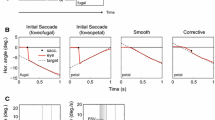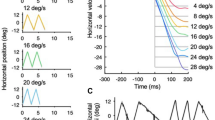Abstract
In man, the saccadic response to a visual random unpredictable target is known to have a delay of about 250 msec. When the target motion is a periodic square move in the horizontal plane, this delay gradually decreases as the tracking proceeds, until the eye actually overtakes the target. Thereafter, the eyes continue to move accurately with the target with little or no time lag (Stark et al., 1962; Dallos, Jones, 1963; Fuchs, 1967). This prediction is not an “either-or” property of the prediction system (Michael, Melvill Jones, 1966; Stark, 1968). When a subject is presented with a periodic square wave target, after about 10 cycles a rapid buildup of prediction occurs, changing the periodicity and changing the (mean) prediction depending on the cycle duration.
Access this chapter
Tax calculation will be finalised at checkout
Purchases are for personal use only
Preview
Unable to display preview. Download preview PDF.
Similar content being viewed by others
References
Dallos PJ and Jones RW (1963) Learning behavior of the eye fixation control system. IEEE Trans. Autom. Control. AC-8, 218–227.
Fuchs AF (1967) Periodic eye tracking in the monkey. J. Physiol. 193, 161–171.
Michael JA and Melvill Jones G (1966) Dependence of visual tracking capability upon stimulus predictability. Vision Res. 6, 707–716.
Stark L (1968) Predictive control. In Stark L, Neurological control systems, studies in bioengineering, pp.236–249. New York, Plenum Press.
Stark L, Vossius G and Young LR (1962) Predictive control of eye tracking movements. IRE Trans. Hum. Factors Electron. HEE-3, 52–57.
Sugie N (1971) A model of predictive control in visual target tracking. IEEE Trans. Sys. Man Cybern. SMC-1, 2–7.
Author information
Authors and Affiliations
Editor information
Editors and Affiliations
Rights and permissions
Copyright information
© 1982 Dr W. Junk Publishers, The Hague, Boston, London
About this paper
Cite this paper
Ron, S. (1982). Dependence of Saccadic Prediction on Asymmetrical Periodic Stimulus. In: Roucoux, A., Crommelinck, M. (eds) Physiological and Pathological Aspects of Eye Movements. Documenta Ophthalmologica Proceedings Series, vol 34. Springer, Dordrecht. https://doi.org/10.1007/978-94-009-8000-6_7
Download citation
DOI: https://doi.org/10.1007/978-94-009-8000-6_7
Publisher Name: Springer, Dordrecht
Print ISBN: 978-94-009-8002-0
Online ISBN: 978-94-009-8000-6
eBook Packages: Springer Book Archive




